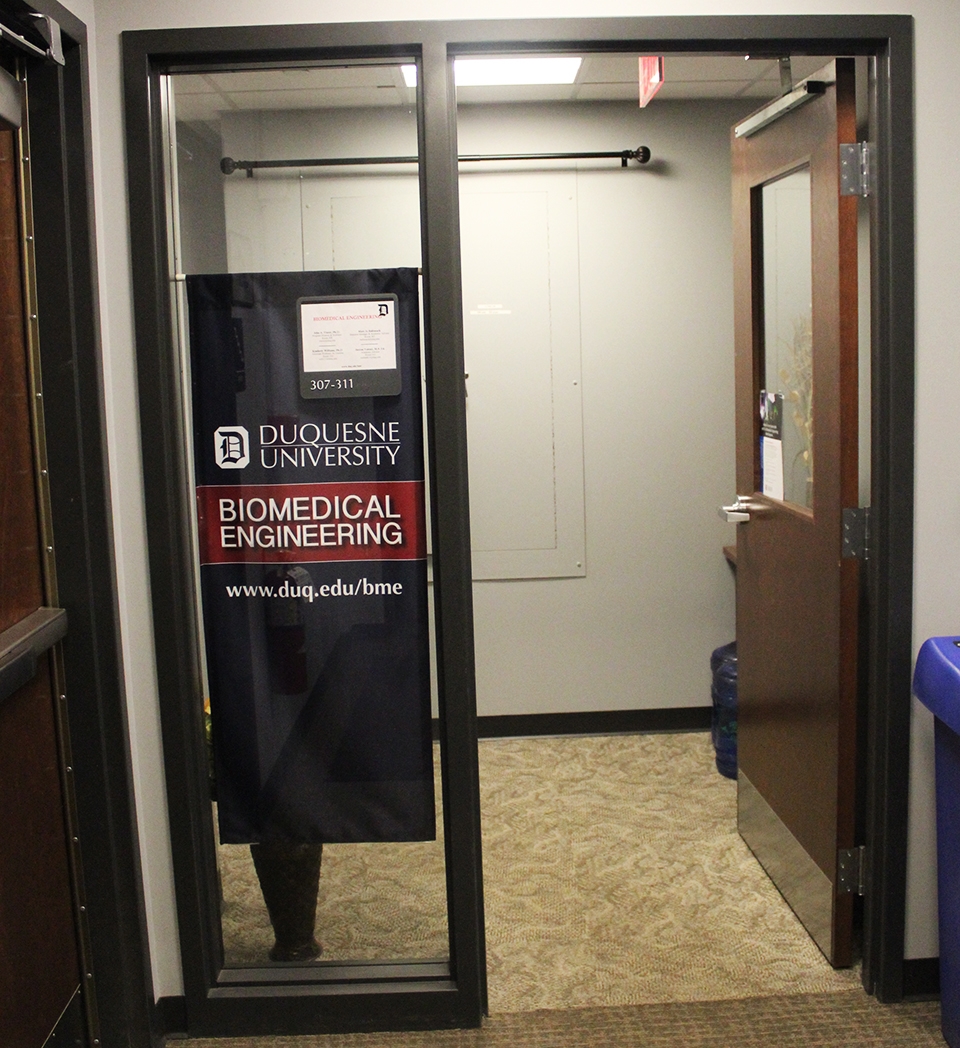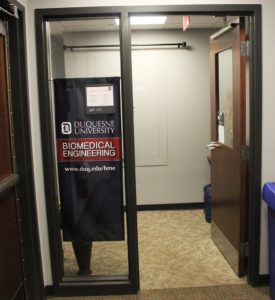
A team of Duquesne biomedical engineering students will be going to Houston in May.

A team of Duquesne biomedical engineering students will be going to Houston in May.
Gabriella DiPietro | Assistant News Editor
04/26/18
Duquesne University is an institution with many connections not only throughout the nation, but across the world. Now, it is attempting to expand its reach even further — into space.
A team of students at Duquesne is one of 25 advancing to the testing phase of NASA’s Microgravity Neutral Buoyancy Experiment Design Teams (Micro-g NExT) competition, in which students must produce and design a device that can cut and retain zip-ties in space.
NASA requires that the zip-tie cutter be a handheld device with no sharp or pointed edges. The device must also rely on manual operating power and be able to be used ambidextrously.
The undergraduate students will travel to the Johnson Space Center in Houston, Texas for a round of testing in May. This will take place in a 40-foot-deep pool at NASA’s Neutral Buoyancy Laboratory, where astronauts train for spacewalks.
The opportunity for this project was found by sophomore physics and biomedical engineering double major Madelyn Hoying while applying for NASA internships. She is currently interning at the NASA Langley Research Center this semester.
According to Hoying, who is leading the team, they started the project in October by submitting a proposal and were selected by NASA in November to continue their work.
The students meet once or twice a week to work on the zip-tie cutter and other surrounding duties. Team members are delegated different roles and assignments, while some students handle the design, some are in charge of fundraising and others handle the community outreach portion of the project.
Clare Flanagan, a freshman biomedical engineering student involved in the project, detailed some of the team’s efforts.
“As part of the project, we had to do community outreach in which we went to a few high schools and presented our project, taught a related lesson on the physics of it and promoted NASA and STEM,” Flanagan said. “It was at one of these outreach opportunities that we got local news coverage, which I then shared with Dr. John Viator, who then tweeted that out. This garnered us the attention of the rest of Duquesne, for which we are very grateful.”
According to Flanagan, about 75 iterations of the product were invented before they settled on their final design. The team used 3D printers and other instruments for the production of the device.
Hoying explained the significance of this project and competition, noting how it has real-life effects and influences.
“This is important to NASA because it addresses an issue that the astronauts run into when in space,” Hoying said. “Using normal scissors to cut zip ties won’t work, because any fragments become hazards if they float around in space. So, our device addresses this by collecting the fragments and preventing hazards in space.”
This importance was echoed by Flanagan, who noted that this competition grants NASA the chance to “outsource to young engineers and utilize their creativity and innovation from an outside perspective, which is a great way to go about progress. They get fresh takes on old problems in this way, and they can then move forward.”
Flanagan also emphasized that the participating Duquesne students chose to work on this project in addition to their coursework and extracurricular activities.
“We are not a club, nor are we doing this for any class. We are just a group of STEM students who were willing to step up to a real challenge, and so far, we have been met with success,” Flanagan said. “We are going up against schools such as Columbia, UCLA and Texas, to name a few. And if we at Duquesne can stand among them as a contender, that would be pretty neat and certainly boost Duquesne’s prominence.”
Benjamin Goldschmidt, assistant professor of biomedical engineering and the team’s mentor, also highlighted how the students’ efforts could one day result in their device’s use on the International Space Station.
“The project is an important test of our students’ knowledge and ability in regard to basic engineering principles,” Goldschmidt said. “If they are successful, their prototype may one day end up being used by real astronauts in space to cut zip ties safely and effectively so that they can deploy various devices on board the spacecraft and in the microgravity environment.”
Any students interested in participating in NASA competitions should contact Madelyn Hoying at hoyingm@duq.edu.
In order to go to the competition, the team is running a crowdfunding campaign. Those who wish to donate or learn more can visit spirit.duq.edu/project/10240.


